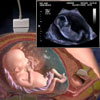- Introduction to pregnancy ultrasound
- How do pregnancy ultrasounds work?
- Why would you have a prenatal ultrasound?
- How is an ultrasound performed?
- When would you have an ultrasound?
Introduction to pregnancy ultrasound
An obstetric ultrasound, also known as a prenatal ultrasound scan, can screen for and diagnose birth defects and / or hereditary conditions. An obstetric ultrasound is an ultrasound of your pelvis which produces an image of the foetus in the uterus.
How do pregnancy ultrasounds work?
A probe is used to pass sound waves into the body. An image of the baby is produced by the reflection of those sound waves. The images (sonogram) are displayed on a television screen. The sonographer performing the ultrasound can explain these images to you.
Appropriate use of ultrasound poses no physical risk to you or your baby.
Why would you have a prenatal ultrasound?
You may have an ultrasound to check the development of your pregnancy. This includes:
- Confirming the stage of the pregnancy;
- Checking the continuation of a pregnancy if there has been bleeding;
- Identifying a multiple pregnancy;
- Checking the position of the placenta;
- Checking the amount of amniotic fluid;
- Checking the physical development of the foetus; and
- Diagnosing birth defects and/or hereditary conditions.
A prenatal diagnostic ultrasound can detect physical abnormalities including:
- Congenital heart defects: Abnormalities of the structure and function of the heart occur in 1 in 100 pregnancies;
- Limb reduction defects: Short or missing bones in the arm or leg occur in 1 in 1000 pregnancies;
- Cleft lip palate: Failure of normal closure of tissue in the lip palate area occurs in 1 in 1000 pregnancies;
- Neural tube defects: Abnormalities of the brain, skull, spine and spinal cord (e.g. spina bifida) occur in 1 in 500 pregnancies in Western Australia.
How is an ultrasound performed?
There are two ways in which obstetric ultrasound can be performed.
Abdominal ultrasound
- Abdominal ultrasound is the most common procedure and can be used at any stage of pregnancy;
- A gel is applied to the abdomen to allow the sound waves to pass from the transducer into the uterus;
- The bladder should be comfortably full to gain a clear ultrasound picture.
Vaginal ultrasound
Vaginal ultrasound is less commonly performed. It is usually restricted to the first trimester (up to 12 weeks) of pregnancy. The bladder needs to be completely emptied in order to perform this method of ultrasound.
When would you have an ultrasound?
In first trimester it is common for an ultrasound to be performed to confirm the gestation of the pregnancy. An ultrasound can be performed as part of a screening test at 11-14 weeks to screen for Down’s Syndrome. This screening test involves a blood test to measure two hormones, free B-HCG and PAPP-A, as well as an ultrasound scan. The ultrasound measures the nuchal translucency of the baby.
It is common medical practice to also offer an ultrasound scan, called the ‘foetal anatomy’ scan, at 18-20 weeks. This scan looks for the presence of physical abnormalities in the baby.
The ability to diagnose physical abnormalities depends on the equipment used, the position of the foetus, the stage of the pregnancy and the experience of the person performing the ultrasound.
What do the results mean?
If a physical abnormality is identified, it may suggest the presence of a birth defect and/or hereditary condition. Your doctor may recommend a further prenatal diagnostic test such as amniocentesis or chorionic villus sampling. These tests can definitively exclude or confirm the presence of a specific birth defect. Ultrasound is usually used to guide these procedures.
More information
 |
For more information about pregnancy, including preconception advice, stages of pregnancy, investigations, complications, living with pregnancy and birth, see Pregnancy. |
 |
For more information about different pregnancy investigations, including pregnancy tests, obstetric ultrasound, amniocentesis and chorionic villus sampling as well as useful tools and animations, see Pregnancy Investigations. |
References
- Campbell, S., Warsof, S. L., Little, D. and Cooper, D. J. ‘Routine ultrasound screening for the prediction of gestational age’, Obstetrics and Gynecology. 1985; 84(1-5).
- Chudleigh, T. and Thilaganathan, B. Obstetric ultrasound: How, Why and When. London, Elsevier Churchill Livingstone, 2004.
- Levine, A. B. and Lockwood, C. J. ‘Ultrasound as an ancillary investigation in the management of pregnancy’ In: Antenatal and neonatal investigations. Ed: Leck, I. and Wald, N. Oxford, Oxford University Press, 2000.
- Norwitz, E. and Schorge, J. Obstetrics and Gynaecology. Massachusetts, Blackwell Publishing, 2006.
- Robinson, H. P. and Fleming, J. E. E. ‘A critical evaluation of sonar crown-rump length measurements. ‘ British Journal of Obstetrics and Gynaecology. 1975; 82(100-7).
- Wald, N., Kennard, A., Donnenfeld, A. and Leck, I. ‘Ultrasound scanning for congenital abnormalities’ In: Antenatal and neonatal screening. Ed: Wald, N. and Leck, I. Oxford, Oxford University Press, 2000.
- Waldenstrom, U., Axelsson, O. and Nilsson, S. A. ‘Comparison of the ability of a sonographically measured biparietal diameter and the last menstrual period to predict the spontaneous onset of labor.’ Obstetrics and Gynecology. 1990; 76(336-8).
- Woo, J., ‘Obstetric Ultrasound.’ [online], 2006. Available at http://www.ob-ultrasound.net/omeasure.html: http://www.ob-ultrasound.net/omeasure.html (last accessed: 13/12/2006).
All content and media on the HealthEngine Blog is created and published online for informational purposes only. It is not intended to be a substitute for professional medical advice and should not be relied on as health or personal advice. Always seek the guidance of your doctor or other qualified health professional with any questions you may have regarding your health or a medical condition. Never disregard the advice of a medical professional, or delay in seeking it because of something you have read on this Website. If you think you may have a medical emergency, call your doctor, go to the nearest hospital emergency department, or call the emergency services immediately.







